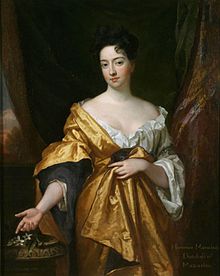Hortensia Mancini

Hortensia Mancini , also French: Hortense Mancini, (born June 6, 1646 in Rome , † November 9 or July 2 or July 16, 1699 in Chelsea ) was one of the so-called Mazarinettes (French: Mazarinettes ) and mistress of the English King Charles II. As a result of her marriage in 1661 she was named Duchess of Mazarin.
Life

Hortensia was the daughter of Michele Lorenzo Barone di Mancini and his wife Geronima Mazarini and thus the niece of Cardinal Jules Mazarin . She came to Paris from Italy at the age of seven . Together with her sister Maria she was the most beautiful of the so-called Mazarinettes (she was even considered the most beautiful woman of her time after Ninon de Lenclos ) and the declared darling of her uncle. This determined her to heir to the title Mazarin on the condition that her husband accept the coat of arms and the title Mazarin. She was married in 1661 to Armand-Charles de La Porte , Marquis of La Meilleraye, who assumed the title Duke of Mazarin and Duke of Mayenne. His father, the Duke Charles de La Meilleraye, was Marshal of France . As a relative of Richelieu , Armand de La Porte was one of the few greats of the kingdom who remained loyal to Mazarin. After Mazarin's death, his heiress Hortensia was the richest woman in France.
Despite having numerous children, the marriage was unhappy. Armand was probably suffering from a mental disorder. Hortensia moved to the monastery in 1666 and fled two years later to Rome and from there to her sister Maria at the court of Savoy. She lived in restlessness and adventurous, became popular because of her skilled handling of swords and pistols and her preference for appearing in men's clothing. Hortensia was temporarily mistress of Duke Charles Emanuel II (Savoy) . In 1675 she wrote her memoirs and in the same year she arrived at the court of Charles II of England, whose lover she became. She received from him an annuity and a small castle in the London park of St. James. There she ran a literary salon , which Saint-Réal also frequented.
The fatal outcome of a duel between two other admirers caused her to seek refuge in a monastery. The writer Charles de Saint-Évremond persuaded her to show herself again in her drawing room; she would remain his close friend for many years to come. Towards the end of her enjoyable life, she became a drinker. Seriously ill, she dies during a cure. The husband, who still jealously desired her, saw her again in her coffin after more than twenty years of separation. He finally buried her in a tomb next to Mazarin himself in 1700.
De Mazarin leaves behind three daughters and a son, Paul Jules. His great-granddaughter brought the title Mazarin to the Grimaldi family in 1777 ; the Prince of Monaco leads it to this day.
- See also: Mazarin-Mancini House
Individual evidence
- ↑ without receipt
- ↑ Armin Strohmeyr : Adventure of traveling women. 15 portraits: Hortense de Mazarin (1646–1699) , Piper, Munich 2012, ISBN 978-3-492-27431-9 , p. 36.
- ↑ a b c d Antonius Lux (ed.): Great women of world history. A thousand biographies in words and pictures . Sebastian Lux Verlag , Munich 1963, p. 308.
literature
- Pierre Combescot : Les petites Mazarines . Grasset, Paris 1999, ISBN 2-253-14982-9 .
- Grant Hayter-Menzies: Shadow on Earth. Hortense Duchess Mazarin . In: The European History Journal . No. 5, 1998.
- Armin Strohmeyr : Adventure of Traveling Women. 15 portraits: Hortense de Mazarin (1646–1699) , Piper, Munich 2012, ISBN 978-3-492-27431-9 , p. 22 ff.
Web links
| personal data | |
|---|---|
| SURNAME | Mancini, Hortensia |
| ALTERNATIVE NAMES | Mancini, Hortense |
| BRIEF DESCRIPTION | Duchess of Mazarin |
| DATE OF BIRTH | June 6, 1646 |
| PLACE OF BIRTH | Rome |
| DATE OF DEATH | July 16, 1699 |
| Place of death | Chelsea |